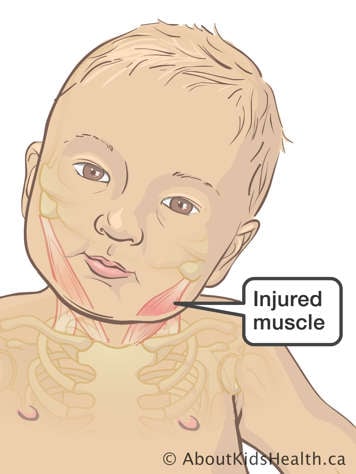What is torticollis?

Congenital muscular torticollis occurs when a muscle of the neck, called the sternocleidomastoid, is shorter on one side of the neck than the other. The tight muscle causes a baby’s head to tilt toward the side of the neck with the shortened muscle and the head to be turned away from that side. It is called “congenital” in infants who are born with this condition, even though it may take a few weeks or a few months to diagnose the condition.
While the full name for this condition is congenital muscular torticollis, it is often simply referred to as torticollis.
Causes of congenital torticollis
There are different theories as to why torticollis may happen. While there are non-muscular causes of congenital torticollis, such as abnormalities of the bones in the skull or neck, about 80% of babies have congenital muscular torticollis.
In congenital muscular torticollis, the muscle can become short due to the position of the fetus during pregnancy. This problem can also occur because the neck muscle was stretched during birth, and the stretched muscle then healed with scar tissue. It would be this scar tissue that causes the muscle to become tight and short.
Rarely, torticollis can develop in infants after birth. This is called acquired torticollis. This happens if your baby keeps their head turned to one side more than the other. When this happens, the neck muscles can become tight.
Questions about torticollis
Why does my child prefer to look in one direction?
A child with torticollis may tend to look in only one direction. The shortened neck muscle causes the head to be tilted towards it. The chin turns away from it. This is why your child prefers to look away from the tight muscle.
If your baby is always on their back or prefers to look in one direction, part of their skull may become flat. This condition is called positional plagiocephaly. Positional plagiocephaly means flattening of the skull. Torticollis and plagiocephaly are closely associated with one another.
What should I do if my child only looks in one direction?

If your baby prefers to look in one direction, you should encourage them to look to the less-preferred side until they look equally in both directions. Your baby may have a tight muscle in their neck and they may need specific stretches. You should speak totheir health-care provider or to a physiotherapist for more information.
In the meantime, here are some things you can do:
- During playtime, use mobiles or brightly coloured toys to encourage your baby to look in the less-preferred direction.
- When you are holding or feeding your baby, hold them in a way to encourage them to look in the less-preferred direction.
- If your baby's crib is against the wall, put them at opposite ends of the crib each night. Babies prefer to look out into the room.
- Daily tummy time can help stretch and strengthen neck muscles.

If your baby prefers to look in one direction, you should encourage them to look to the less-preferred side until they look equally in both directions. Your baby may have a tight muscle in their neck and they may need specific stretches. You should speak to your doctor or to a physiotherapist for more information.
In the meantime, here are some things you can do:
- During playtime, use mobiles or brightly coloured toys to encourage your baby to look in the less-preferred direction.
- When you are holding your baby, hold them in a way to encourage them to look in the less-preferred direction.
When to seek medical assistance
If you feel your baby has limited neck movement or is holding their head tilted or turned to one side, speak to their health-care provider. They may refer you to a physiotherapist.
After assessing your child's head and neck, the therapist will design a home program for your baby. You may be given exercises and other recommendations. These exercises are very effective but may need to continue for several months.
Stretching exercises, positioning changes and tummy time all work together to ensure a baby develops good range of motion of their neck muscles with no head tilt.
Virtual care services for children
Boomerang Health was opened by SickKids to provide communities in Ontario with greater access to community-based services for children and adolescents. For more information on virtual care services in Ontario to support neurodevelopmental physiotherapy, visit Boomerang Health powered by SickKids.